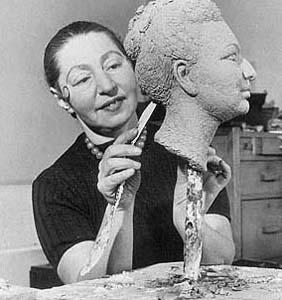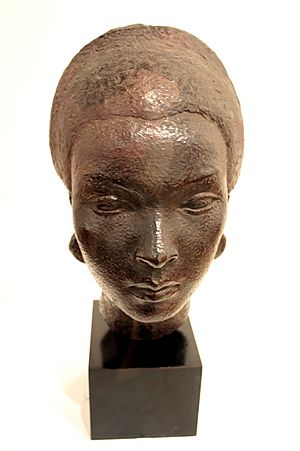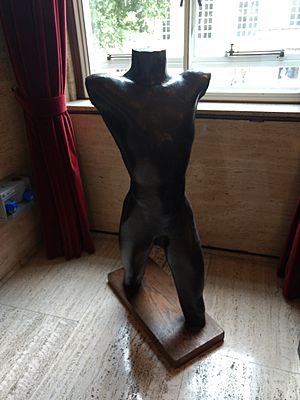Dora Gordine facts for kids
Quick facts for kids
Dora Gordine
|
|
|---|---|
 |
|
| Born | 8 June 1895 |
| Died | 29 December 1991 (aged 96) Kingston upon Thames, Surrey, England, UK
|
| Nationality | Estonian |
| Known for | Painting, sculpture, interior design |
|
Notable work
|
Happy Baby, Mother and Child, head sculptures, Dorich House |
| Awards | Fellow of Royal British Society of Sculptors (FRBS), Society of Portrait Sculptors |
Dora Gordine (born June 8, 1895 – died December 29, 1991) was an Estonian sculptor. She created modern art, especially statues of people. Her early work was inspired by a group of artists called 'Young Estonia'.
Dora moved to Paris, France, and later married Richard Hare. After her marriage, her career really took off. Many people thought she was one of the best sculptors of her time. She was famous for making sculptures of people's faces and bodies. Important people from politics, art, and theater admired her work.
She also created several large sculptures for public places. Later in her life, she didn't create as much art. Because of this, she was not very well known when she passed away. However, major art shows in London in 2006 and 2009 helped bring her work back into the spotlight. Her former home is now a museum where you can see her art.
Contents
Dora's Early Life
Dora Gordine's childhood story is not fully known. She was born in Liepāja, Latvia, which was part of the Russian Empire back then. Her parents, Morduch and Emma, were Russian Jews. Dora was the youngest of four children. Her family was comfortable, and they could afford to send her older brother, Leopold, to study engineering. Her older sister, Anna, also studied at a top art school.
Around 1912, Dora's family moved to Tallinn, Estonia. Her unique style of sculpture was greatly shaped by the 'Young Estonia' art group. This group liked a style called Art Nouveau, which uses flowing lines and natural shapes. Dora showed her bronze sculptures in Tallinn in 1917, 1920, and 1921.
In 1924, she went to Paris to study French culture. There, she learned more about modern French sculpture. She felt a strong connection between music and sculpture. This helped her develop her own artistic ideas. Dora changed her last name to Gordine, adding an "e" to make it sound more Russian.
In 1925, she painted a mural for the British Pavilion at a big art show in Paris. This job helped her pay to create a bronze sculpture for another exhibition. The next year, she was invited to show her art at the Salon des Tuileries. Her sculpture of a Chinese philosopher's head and body received great reviews. One newspaper even wrote that she "woke up famous" overnight!
Between 1929 and 1935, Dora made bronze sculptures for the City Hall, Singapore. In 1928, the Leicester Galleries in London held a special show just for her sculptures. It was a huge success, and all her artwork was sold. One famous piece, Javanese Head, was bought by Samuel Courtauld for the Tate Gallery.
Dora's Marriages
In 1930, Dora married her second husband, Dr. George Herbert Garlick, in Singapore. Later, in 1936, she married her third husband, Richard Gilbert Hare. Richard came from an important family.
Being married to Richard meant Dora became part of a group of artistic and open-minded people. Richard's income allowed Dora to build a special house called Dorich House in Kingston Vale, England. This house was her art studio and a place to show her sculptures. It also displayed their amazing collection of Indian, Chinese, and Russian art.
Her Sculpting Career
Dora's husband introduced her to many important people in London. Many of them sat for her, meaning they posed so she could sculpt their portraits. These included famous actors like Dame Edith Evans and Dame Beryl Grey. She also received commissions from other countries. One example is the Kwa Nin sculpture, which Dora called The Chinese Lady of Peace. She also made a low-relief sculpture for Gray's Inn in honor of Sun Yat-sen, a former leader of China.
Each portrait head Dora made had its own unique finish. This finish matched how Dora saw the person she was sculpting. In a 1972 interview, Dora explained that when you sculpt a portrait, it's not just about the nose and mouth. She said, "You have to imagine what they are like inside and bring out their inner feeling and then put it in a form."
When World War II began, Dora's career slowed down. She couldn't use her favorite bronze foundry in Paris anymore. Bronze metal also became hard to get because it was needed for the war. All foundries in Britain had to stop making non-essential items. It wasn't until late 1943 or early 1944 that she found a new foundry. This allowed her to show some of her latest bronze work at the Royal Academy of Arts in 1944.
During the 1940s and 1950s, Dora's art was often shown at the Royal Academy. It was also displayed at the Society of Portrait Sculptors and other places. In October 1945, she had a solo show at the Leicester Galleries. The Times newspaper said she had "much ability." They noted she was influenced by many different art styles, including Indian and Egyptian art. Her best works were her bronze portrait heads, which were "convincing and straightforward."
Some of her bronzes from this time had funny or ironic names. These names often related to the pose of the sculpture. Examples include Great Expectations and Mischief. A sculpture of an RAF Officer was called Above Cloud. In 1949, she became a Fellow of the Royal British Society of Sculptors. She also traveled and gave lectures in America. In 1947, she worked in Hollywood, lecturing about art and designing movie sets. She visited the US again in 1959.
In 1948, Dora was asked to create a sculpture for a new mother and baby unit. This unit was at HM Prison Holloway in north London. The sculpture, called Happy Baby, was largely forgotten for many years. But by 2009, it was seen as a very important piece of her work. It became the main focus of an exhibition at Kingston University in 2009. Dora's work was also part of the art competition at the 1948 Summer Olympics.
In 1960, a company called Esso asked her to create a large low-relief sculpture. This piece, called Power, was for their new oil refinery. The Duke of Edinburgh revealed it to the public. Dora's last public sculpture was Mother and Child. This 2.5-meter-long piece was made for the entrance of the Royal Marsden Hospital in Surrey in 1963.
Later Life and Legacy
Dora's husband died suddenly in 1966. She lived alone in Dorich House after that. She did not have any children. As Dora got older, she had fewer clients. Health problems also made it harder for her to work. Her eyesight got worse, and she had arthritis in her shoulders and arms. Because of this, her career ended in the 1970s.
She loved her garden, especially plants used for medicine. She often invited students from the Royal Ballet School to Dorich House to pose for her. Dora Gordine passed away in Dorich House in December 1991, at about 96 years old.
After her death, her work became popular again. This was thanks to big art shows in London. These included exhibitions at the Ben Uri Gallery & Museum in 2006 and at Dorich House and Kingston University in 2009.
Dorich House
Dora Gordine designed Dorich House herself, and it was finished in 1936. The name "Dorich" is a mix of Dora and Richard's names. The house has three floors. The first two floors were used for creating and showing Dora's sculptures. The top floor was where Dora and Richard lived.
In 1994, Kingston University bought Dorich House. It was fixed up and opened as a museum in 1996. The museum now holds Dora's collection of bronze and plaster sculptures. It also has many of her paintings and drawings. You can also see items from Richard Hare's collection of Russian art. This includes old religious paintings, ceramics, glass, metalwork, and furniture.
Major Art Shows
- Salon de Tuileries, Paris (1926, 1933)
- Leicester Galleries, London (1928, 1933, 1938, 1945, 1949)
- Royal Academy of Arts (1937–1941, 1944–1950, 1952–1960)
- Battersea Park Arts Council (1948)
- Fine Art Society, London (1986)
- Jewish Museum London (2006)
- Kingston University, London (2009)



